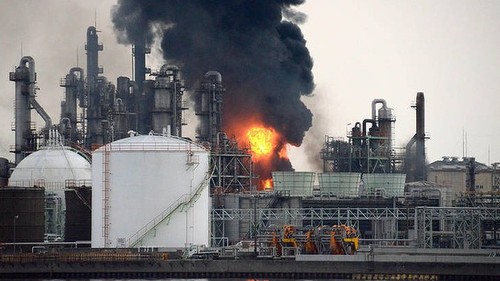
image via brisbanetimes
There's nothing like an explosion in a Japanese superabsorbent polymer factory to throw the disposable diaper industry analysts into a frenzy. Literally, before the smoke had cleared, and the injured firefighters had been accounted for, headlines were warning of a looming diaper shortage because 20-25% of the global capacity for SAP had been blown up.
Which, really? Let's take a look.
The incident took place on Saturday, Sept. 29 at the Nippon Shokubai manufacturing facility in Himeji, west of Osaka. One firefighter was killed and 35 other people were injured when an acrylic acid tank, which had been burning, exploded.
Himeji's 320,000 metric ton production capacity represents about 20% of the 1.7 million tonnes of SAP produced worldwide. Nikkei reports company officials are expecting the facility to be offline for at least six months for an investigation and repairs.
Nikkei also says that Shokubai was operating near capacity already, and so it would be difficult for the rest of the company to ramp up SAP production.
So perhaps the question is, what is the impact on Big Diaper of losing Himeji for six months? Could Nippon Shokubai pick up the slack, or could other players step in to fill the gap?
The SAP market is dominated by a handful of major players. BASF reportedly has 470,000 tons of capacity. Which is also the number claimed [link to pdf] by Evonik, another German company, which has recently rolled up the SAP operations of companies like Dow, Degussa and Stockhausen. Sumitomo Seika [160,000], LG Chem, and Sanyo round out the field.
SAP factories are distributed around the world, and in the low-margin, commodity business, they gain cost advantage through vertical integration and by being situated near processing plants for acrylic acid, the main ingredient for making SAP. Acrylic acid's main ingredient, meanwhile, is polypropylene, which comes from oil.
So is there inventory on hand to help ride out the shortfall--like with maple syrup or pork, a Strategic SAP Reserve--or is there excess production capacity that could kick in as needed?
On the first question, the answer seems to be no. Like gas refineries, companies seem to produce to meet demand. Nikkei says Nippon Shokubai has about a month's inventory, whether that's 27,000 tonnes for Himeji, or 40,000 tonnes for their whole system, though, is unclear. In any case, in normal operations, inventory is a cost, an inefficiency to be managed away. The explosion seems less like a contingency that a plant operator would plan for, and more like an extraordinary event, one perhaps caused or exacerbated by failing to follow safety protocols. So no extra SAP lying around.
As for capacity, there's apparently been a pretty steady growth rate, like 5-6%, in SAP production for the last 10-15 years, and companies have been steadily adding capacity to match it. This is presumably caused by an expansion of disposable diaper use in heretofore undiapered markets around the world, places like South America and, obviously, China and India.
If the economic downturn in China or wherever slows diaper uptake, that might free up capacity to cover the loss of Himeji. [Again, a 5-6 month loss would be maybe 150,000 tonnes, which is maybe 8% of current worldwide production.] And if prices for SAP rise, and push diaper prices up with it, that's going to his less affluent markets first, where disposable diapers are still seen as an aspirational purchase, if not a luxury item.
Of course, all of this still assumes that SAP is a pure commodity, and that companies source and ship SAP around the globe, and that diaper manufacturers can swap crystals in and out without anyone noticing. To counter that, SAP producers all try to brand their products and refine their formulations and production processes to lock in customers. To some extent, this is real. The Pampers DryMax mess a couple of years ago was an example of SAP tweaking. And Nikkei claims that this is the case with Nippon Shokubai, too, and so Himeji's primary customer is really the one in trouble here: and that's Pampers, Proctor & Gamble in Asia.
SAP accounts for about a quarter of the materials cost of a diaper. Let's say 30%. In 2004, chem industry researcher ICIS reported, SAP cost $1.66 to 1.90 per kilogram. And it rose 10% in 2005, "primarily due to increased acrylic acid prices."

image: stlouisfed.org
And remember, acrylic acid comes from oil, so it should be expected to rise in price as oil does. But oil went from $40 to $55/barrel between 2004-5, a jump of more than 30%. Yet acrylic acid only increased by 10%? So if oil's double that today, does that mean acrylic acid is, too? Or is it just up by some fraction?
If there's 5g of SAP in a diaper, which I calculated out [16 billion diapers in the US made from 80% of 490,000 metric tons of SAP], that's like a penny's worth of stuff. Is that right? So the direct materials for a diaper cost four cents? If SAP temporarily doubled in price, and that cost jumped to, say five cents, for a product that retails for a quarter or more, do you actually think Big Diaper will hike their prices to cover it?
I've spent an inordinate amount of time this week trying to find out how the global SAP market operates, including putting inquiries in to various chem industry research analysts. One company, Global Industry Analysis, Inc., who has flooded Google with teasers for their SAP report [$4,995], actually responded with a barely rewritten Reuters story about the Himeji explosion. If I ever do hear back from any actual industry experts, I'll be sure to let you know.
But it is the opinion of this diaper watcher that, with the possible exception of Japanese Pampers customers a few months from now, the freakout over a Himeji-related global diaper shortage is bullshit.
Global nappy shortage fears after factory explosion [telegraph.co.uk]





It seems like some days you really miss your Wall St. job...
you try to keep in shape, is all.
Is this stuff used in maxi pads, too? Can you look into any potential Always shortage?